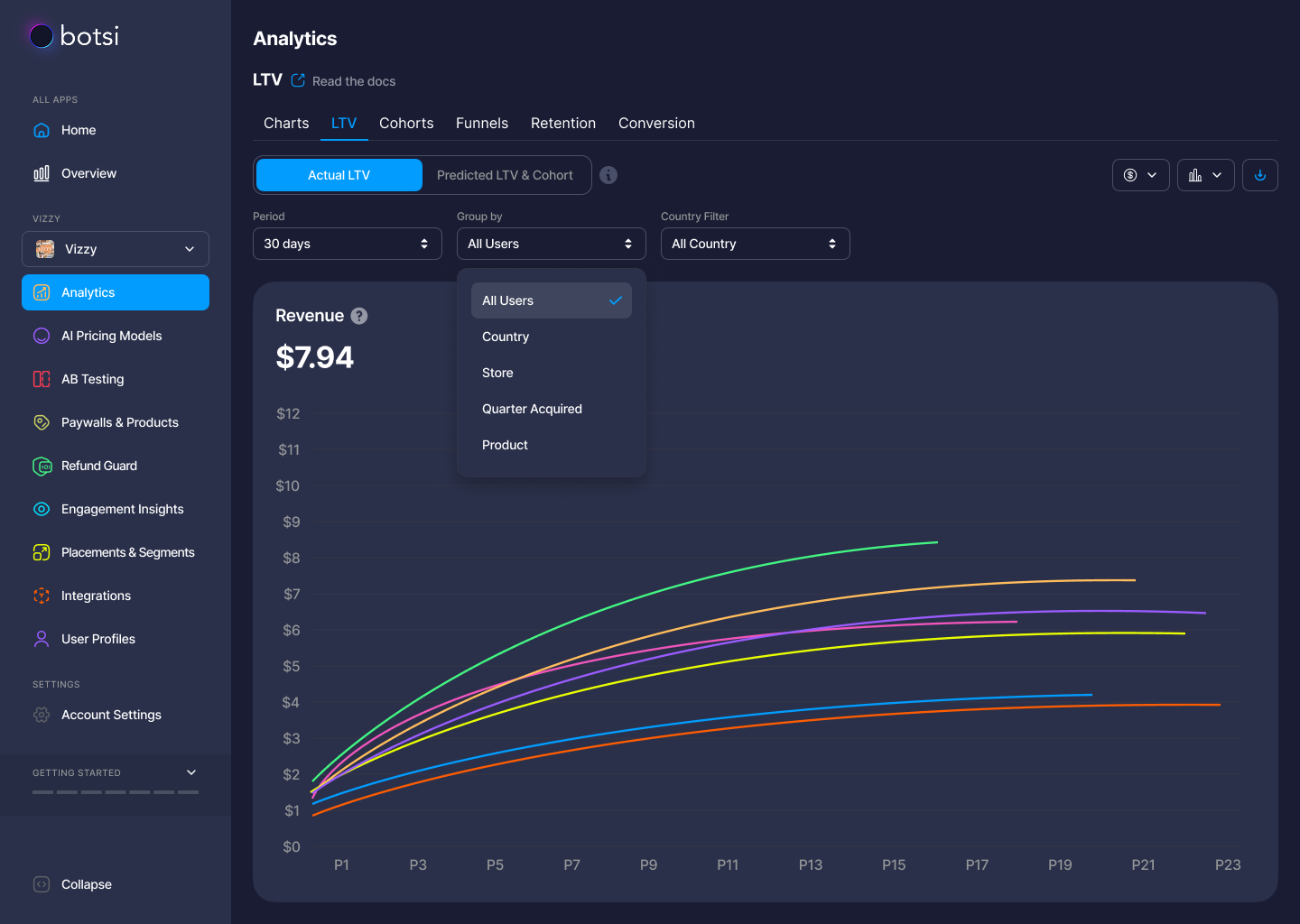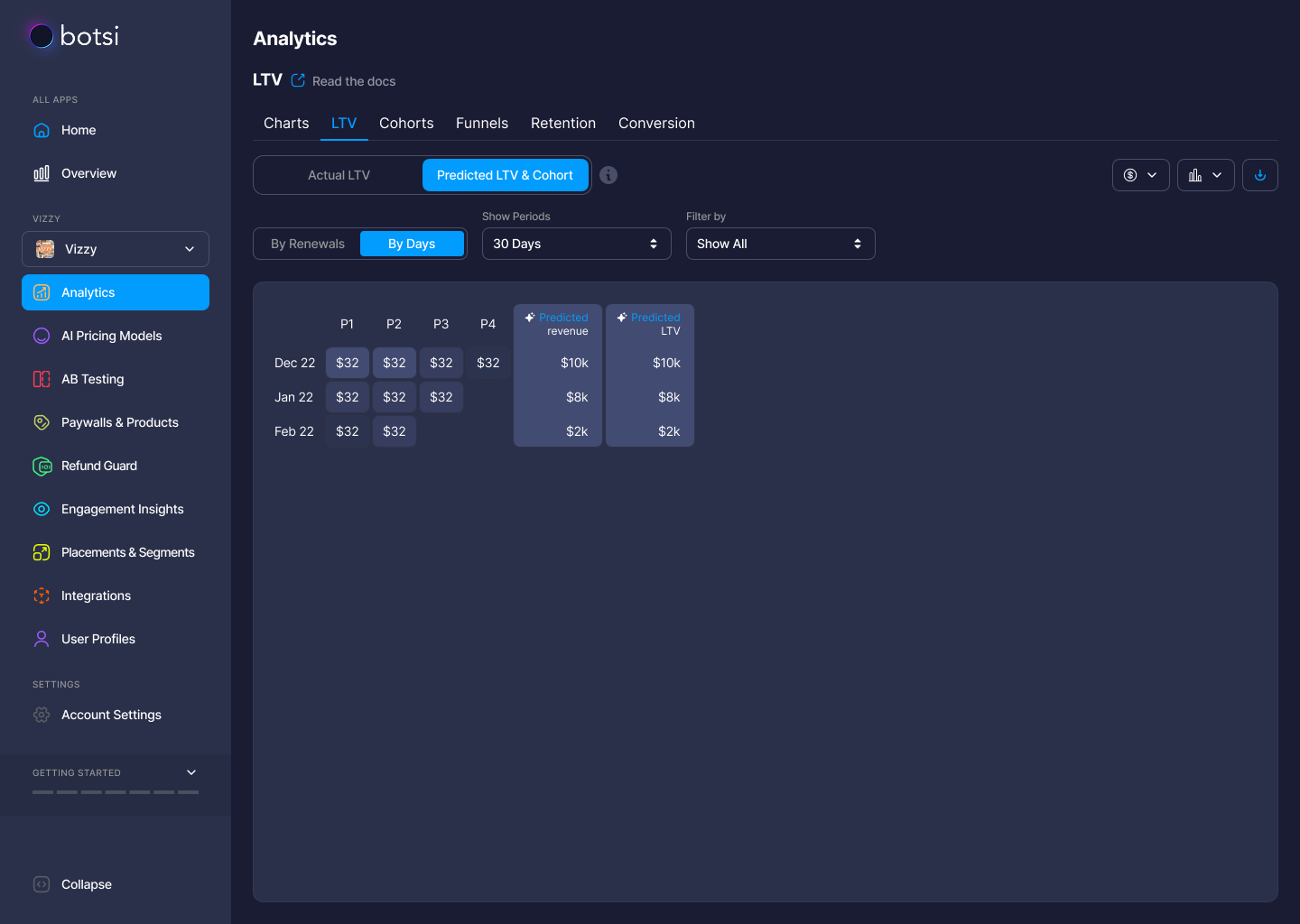Lifetime Value (LTV)
The LTV (Customer Lifetime Value) metric is a key indicator for measuring the total revenue you can expect from a customer over the entire duration of their relationship with your app. It helps you understand how valuable each customer is, not just during their first purchase, but over the course of their time as a paying user.
LTV is essential for understanding the long-term profitability of your customer base. By calculating LTV, you can:
- Measure Customer Profitability: Identify how much revenue each customer generates and which customer segments are the most profitable.
- Guide Marketing Spend: Know how much you can afford to spend on acquiring new customers while maintaining profitability.
- Predict Future Revenue: Estimate future earnings based on your current customer base and their expected lifetime with the app.
Knowing the LTV of your users helps optimize your growth strategy, retention efforts, and marketing spend.
Calculation
In Botsi, LTV is calculated as follows:
LTV = ARPU (Average Revenue Per User) * Customer Lifetime (in months or years)
Example: How LTV is calculated
Let’s assume your app has the following data:
- ARPU of $20 per month
- Customer Lifetime of 24 months (average duration a customer stays subscribed)
The LTV would be calculated as:
LTV = $20 * 24 = $480
Actual LTV
This option provides a snapshot of the historical LTV, calculated based on actual user data over their lifetime with your app. It reflects the true value your customers have contributed up to this point.

You can filter and group the Actual LTV as follows:
- Period
- Filter by: Country
- Group by: All Users, Country, Store, Quarter Acquired, and Product
Predicted LTV & Cohort
This option estimates the future LTV of customers based on historical behavior and trends. It allows you to project the potential revenue from new or existing users over a defined period. Additionally, cohort analysis segments users into groups based on shared characteristics or behaviors, providing insights into how different cohorts are likely to perform in terms of LTV.

LTV by Renewals
The LTV by Renewals view focuses on subscription periods and highlights the first instance when a customer makes a payment. For example, in the case of a weekly subscription, this corresponds to the revenue generated in the subsequent weekly period following the customer’s initial payment. This view provides a clear picture of how renewals contribute to customer lifetime value, helping you track the growth of revenue over time.
LTV by Days
The LTV by Days view organizes and filters data based on different time intervals such as daily, weekly, or monthly. It offers insights into the total revenue generated by users who installed the app during a specific day, week, or month, divided by the number of paying users in that same period. This view is valuable for tracking revenue trends and understanding user behavior over time, helping you make data-driven decisions for user engagement and monetization strategies.
You can filter the Predicted LTV & Cohort as follows:
- By Renewals or By Days
- Periods
- Filter by: ...
Usage
LTV is crucial for understanding the long-term profitability of your customer base. By calculating LTV, you can measure customer profitability, which helps identify how much revenue each customer generates and which segments are the most profitable. It also allows you to guide your marketing spend by determining how much you can afford to spend on acquiring new customers while maintaining profitability. Additionally, LTV helps predict future revenue by estimating how much you can expect to earn from your current customer base based on their expected lifetime value with your app. To maximize LTV, consider the following strategies:
- Customer Retention: Focus on keeping your customers happy and engaged, as increasing customer lifetime is the most direct way to improve LTV.
- Target High-LTV Segments: Identify the segments that generate the most value and tailor your marketing and product strategies to attract more of these users.
- Optimize Pricing Models: Test different pricing strategies to increase customer value over time, such as offering tiered subscription plans or exclusive upgrades.